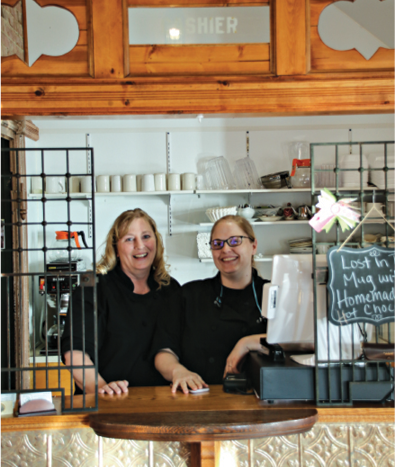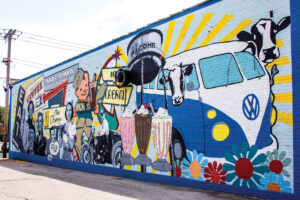 When Sally Goembel brought her husband to the old, worn down bank in Fairbury, Ill., he said, “No way.” He saw a total mess: four brick walls, a filthy floor, and no electricity, heat or plumbing. Sally saw tables, a waitress station and Victorian style decorations. She decided she was going to preserve a little bit of the town’s history and open a restaurant.
When Sally Goembel brought her husband to the old, worn down bank in Fairbury, Ill., he said, “No way.” He saw a total mess: four brick walls, a filthy floor, and no electricity, heat or plumbing. Sally saw tables, a waitress station and Victorian style decorations. She decided she was going to preserve a little bit of the town’s history and open a restaurant.
After 16 years in agriculture, Sally felt she accomplished her goals. “One day, I was driving by here, and I don’t know… you just have a vision,” Sally says. “I watched this building sell three times, and nobody had made a success of it.
“Everything was right. The right time of my life, I had enough money, right ambition and I just moved forward with it. I didn’t look back once I started.”
After a year of renovation, Lost in Time, Inc. opened its doors on Feb. 16, 2009. Sally’s daughter, Sarah Goembel, joined the team later that year as manager. She was attending college for restaurant and hotel management. Sally also has a restaurant background. After high school, she started waitressing and eventually managed the restaurant.
“When we opened, our goal was to provide another venue in town that offers something different,” Sally explains. “We did not want to be like any other restaurant.” The business is incorporated. There’s the Lost in Time restaurant, a bakery next door called Timeless Treats Bakery, and across the street is the Lost Arts retail store.

The mother-daughter team, Sally and Sarah Goembel, stand behind the customized checkout station made with pieces from the original bank.
The building that houses the restaurant is rich with history. Built in 1893 as Claudon State Bank, many businesses came and went in the decades that followed. There were cigar factories, barber shops, cafes, optometrists, insurance agencies and beauty shops.
These businesses have been preserved in a mural on the wall. The mural features A.B. Claudon, the owner of the bank, surrounded by smaller paintings of other businesses that came before.
Parts of the original bank have also been incorporated into the restaurant. “When we bought the building, one of my husband’s cousins came to us and said, ‘You know, when the bank went under, and they had the auction, my dad bought some of the pieces.’”
He then went to his barn and pulled out a rounded piece of wood, iron grates and a glass cashier sign that was used for the bank teller. These were fabricated into a checkout station. Next to this is an oak bar that looks into the bank’s vault.
“The door was gone when we got it,” Sally says. “We cut a hole in the wall and put that bar in because we didn’t want to waste the vault.” They had to cut through five layers of brick to get through the vault wall.
The vault itself is the original bare concrete, but the health department wanted her to paint it. “It’s got little writings, numbers and names on it. I didn’t want to cover it up. It’s history,” Sally notes. So, she had the concrete sealed, and it passed inspection.
Sally and Sarah credit a woman named Susan Slagel as a big part of starting the business. “If Susan wasn’t here, it probably wouldn’t have happened,” Sarah says.
“She was my savior,” Sally says as she remembers receiving a phone call from Susan asking what she was doing with the building, and Sally told her the plan. “She said, ‘I want to be a part of it,’ and I said, ‘You’re hired.’”
Susan left several years later, but her legacy remains. She helped build the original menu, and many of her recipes are used today.
“When the floor was still disgustingly gross and there were no lights, we sat at a 100-year-old table that came with the building and started scratching out a menu,” Sally recalls.
That menu stuck around for nine years until a new menu was launched in mid-January.
“We needed a change,” Sarah explains. “Everything was getting redundant with the same thing every day, but I know a lot of people don’t like change… So, we took the plunge, ripped off the Band-Aid and completely changed the menu.”
“It really shocked the customers,” Sally says. “One day they’re getting their usual, and the next day they’re staring at a brand-new menu… We had changed a few sandwiches here and there, but nothing this drastic.”
They worked with a professional chef to help make changes to the business. The goal was to streamline the menu to get the food out quicker, reduce inventory, be more cost effective and make the business more efficient. The menu wasn’t the only change. Server uniforms and operating hours changed as well.
“If you’re not changing, you’re dying,” Sarah comments. “The world is changing so much, and we’ve got to keep up with the times and follow the trends. There’s always something new to learn or a better way to do something.”
“It’s like you’re always remodeling,” Sally adds.
It’s difficult to determine the crowd favorites because the menu is so new. Some popular items from the original menu stuck around, like the chicken salad and the fried bologna sandwich. The chicken salad is popular because it’s so fresh. It comes right off the farm. It’s cooked whole, deboned, stirred into a dressing made in-house, and served on freshly baked oatmeal bread or a bed of lettuce.
The fried bologna sandwich is a thick slice of bologna with a nice sear, topped with American cheese and a pile of caramelized onions on homemade white bread. The house soup is a cheeseburger chowder, but there is a different soup featured every day.
The rest of the menu consists of salads, sandwiches and breakfast items. The biscuits and gravy and baked oatmeal (an oatmeal cake served with raisins, brown sugar and milk) are popular breakfast items. There are also daily features, so old menu items may occasionally make an appearance.
At the end of a meal, the server brings out a dessert tray, and there’s something new every day. There’s always a selection of pie, cheesecake and a bar dessert. The only item that’s constant on the dessert menu is the cream puffs. These are from a recipe Sally’s mother made from a Betty Crocker cookbook. This crowd favorite is a delicate puff pastry filled with a homemade vanilla pudding and drizzled with chocolate. “If we didn’t have cream puffs, we’d probably better close the door,” Sally says with a chuckle.
When the check comes, customers may find a little treat. “Right now, we’re giving out mini cinnamon rolls,” Sally says. “One day, we gave out appetizers all day, and another day it was cookies. You never know what your gift may be.”
The mini glazed cinnamon rolls are bite-sized and melt in your mouth. The large cinnamon rolls used to be the most popular bakery item, but the minis have overtaken them. They sell in packs of a dozen. “People call them bakery crack because they’re so addicting,” Sally laughs. “If they last to noon, it’s a miracle.”
Everything is made from scratch with no processing involved. Breads are baked fresh, including sourdough and marbled rye. Produce and meats are bought locally, when in season.
The Lost in Time, Inc. restaurant is open Monday through Saturday. Breakfast is served from 7 to 11 a.m., and it closes at 4 p.m. You can view the menu on its Facebook page.


 Lost in Time, Inc.
Lost in Time, Inc.






